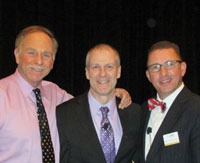An estimated 22,000 attendees from over 90 countries gathered at this year’s Vision Expo East, where the emphasis was on technology to educate, treat and enhance patient care and communication.
 | |
| Friday at Vision Expo, Drs. Jerome Sherman, Jay Haynie and Mark Dunbar rallied the crowd to agree that their class, “Greatest Posterior Segment Course Ever!” really lived up to its name. |
Classroom Tech
Twenty-one hours of crowd-sourced learning classes proved to be insightful and entertaining to those who attended. “Anterior Segment and Contact Lenses,” hosted by Marc Bloomenstein, OD, and Louise Sclafani, OD, encouraged attendees to use their smartphones or tablet devices to actively participate in the session and voice their opinions on the cases presented. This type of audience engagement led to interesting discussions on differences in the determination of diagnosis and treatment protocols.
Drs. Bloomenstein and Sclafani welcomed comments on pictures of ailments displayed on screens. Some participants made educated guesses at a likely diagnosis, while others lent a bit of humor to an already lively class. Although a limited number of classes at VEE offered this level of participation, educators anticipate that the use of this audience response system (ARS) technology will expand for future Vision Expos East and West.
Advancing Care
“What’s New in Eye Care,” presented by optometrists Kirk Smick, Mark Dunbar, Craig Thomas and Peter Shaw-McMinn, reviewed the latest in diagnostic technology, treatments and surgical techniques pertaining to vision and eye health.
 | |
| Audience feedback proved both fun and insightful during the lecture hosted by Drs. Marc Bloomenstein and Louise Sclafani where attendees could take polls, make comments and ask questions using their mobile devices. |
Among the topics discussed was the comanagement of patients who have had microinvasive glaucoma surgery (MIGS). This new technique is performed in conjunction with cataract surgery and involves the placement of an L-shaped microstent into Schlemm’s canal through the same corneal incision made for the intraocular lens. iStent Glaukos is the first and only MIGS stent currently available in the US and is FDA approved for the reduction of intraocular pressure in adult patients with mild to moderate open-angle glaucoma currently treated with ocular hypotensive medication.
Besides surgical advancements, diagnostic advancements in optometric care were also discussed, including the use of OCT. Dr. Dunbar cleverly punned the OCT as being “instrumental” to one’s practice. He noted that although newer, swept-source OCTs are faster and give the practitioner more info, spectral-domain OCTs remain “good for most practices.” Also, spectral-domain OCTs certainly provide greater detail than earlier time-domain OCT models.
Later, on a more serious note in “The Greatest Posterior Segment Disease Course Ever!” Dr. Dunbar added “the development of the OCT has forever changed and elevated eye care.”
Wearable Tech in Healthcare
Besides technological advances in eye care and communication, VEE also showcased the latest in eyewear and eye care technologies. Andrew Karp, group editor of lenses and technology for Vision Monday and 20/20 Magazine, spoke about the latest in wearable tech. He explained that wearable tech devices, such as smart glasses and smart contact lenses, are not only used for virtual reality and augmented reality applications but also for medical reasons. In his course, “Eyewear and Eye Care’s Pivotal Role in Wearable Tech,” he emphasized, “there are many sensor-based systems geared towards health and wellness.”
 | |
| Gary Gerber, OD, rocks the “keytar” at the EyeRock Benefit Concert held in conjunction with Vision Expo East. |
Some devices, such as the Eyes-On Glasses System by Epson and Evena Medical, allow nurses and phlebotomists to see a patient’s veins through the skin, which makes it easier to draw blood. Other smart glasses applications can aid surgeons during delicate procedures by displaying information, such as the patient’s vital signs, in the doctor’s field of vision so that they don’t have to take their focus away from the procedure to check a monitor across the room for information.
How Much Tech is Too Much?
“Digital Eyestrain, Blue Light and UV,” presented by Dr. Smick, Pete Hanlin, LDO, ABOM, and Diana Shechtman, OD, educated eye care professionals on how the ever-changing world of technology can negatively impact our eyes. For instance, overexposure to blue-violet light, like that emitted from LED screens on electronic devices and CFL light bulbs, has the potential to cause retinal damage. Eye care professionals need to know how to protect patients and themselves from the dangers of blue-violet and ultraviolet light as well as the discomfort of digital eyestrain incited by overexposure to the blue light of tablets, smartphones, computer screens and swirly light bulbs. Increasing physical distance away from devices that emit blue light, decreasing screen brightness, limiting time on devices, and taking frequent breaks from them can help to lessen exposure to blue light from artificial sources, the presenters said. Also, lenses that selectively filter some blue light may be worn to further protect patients.

